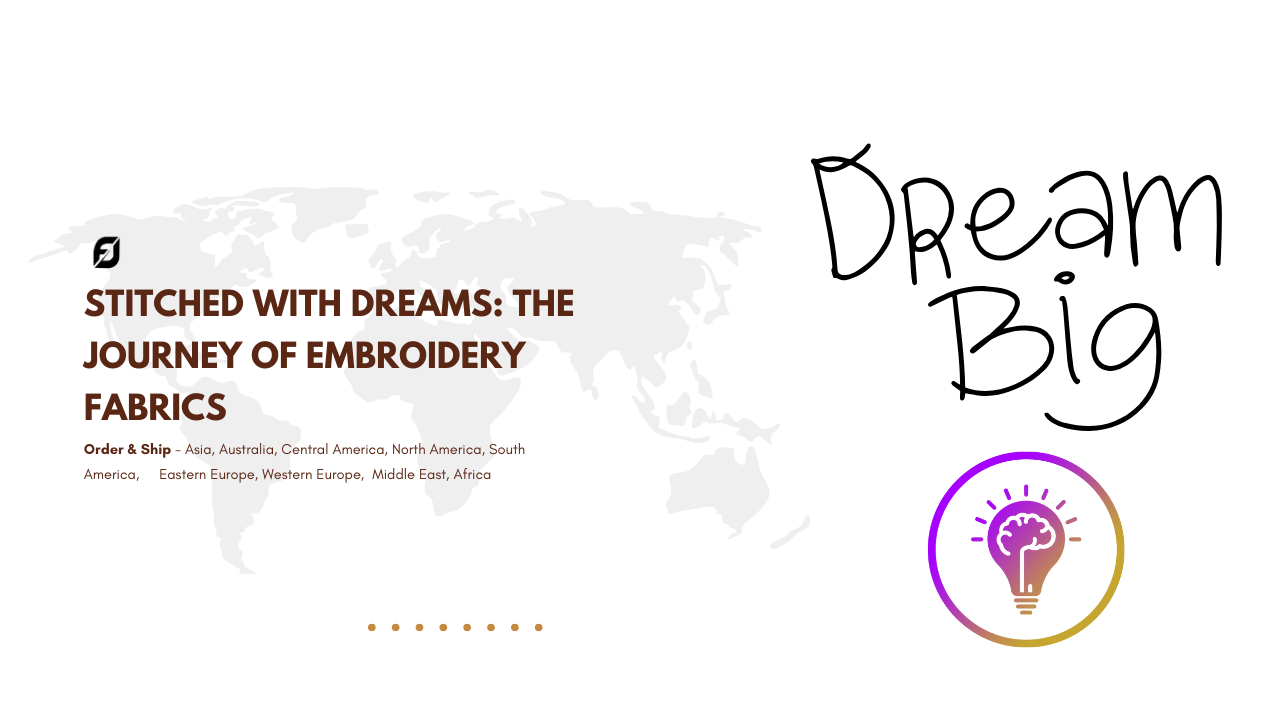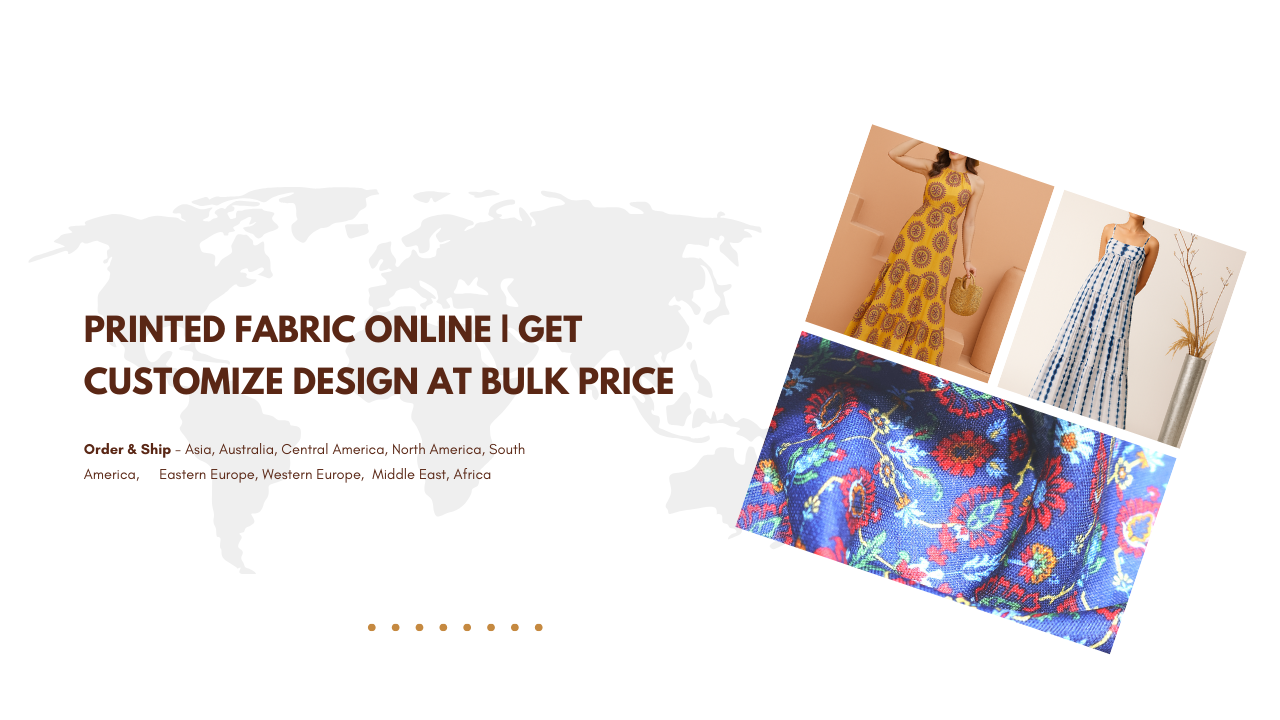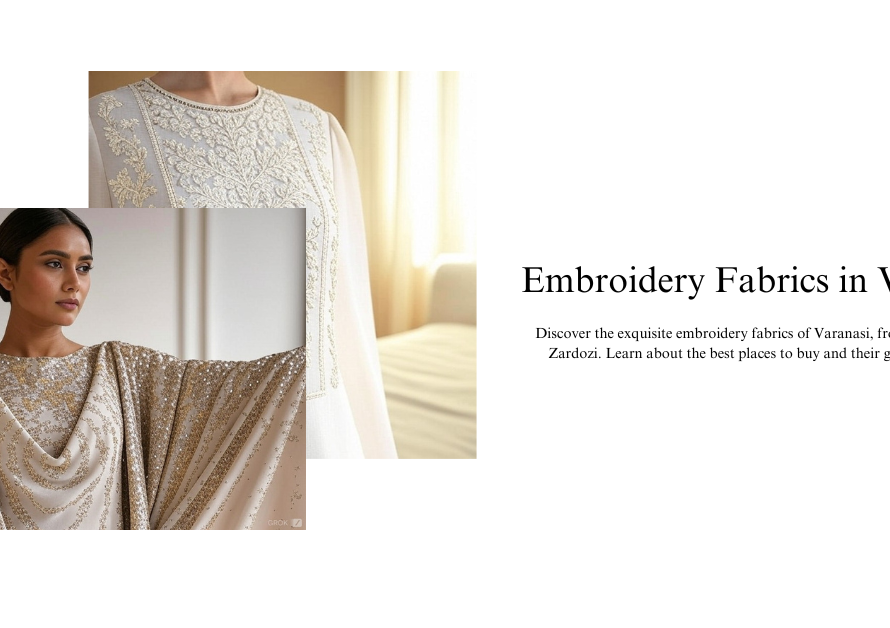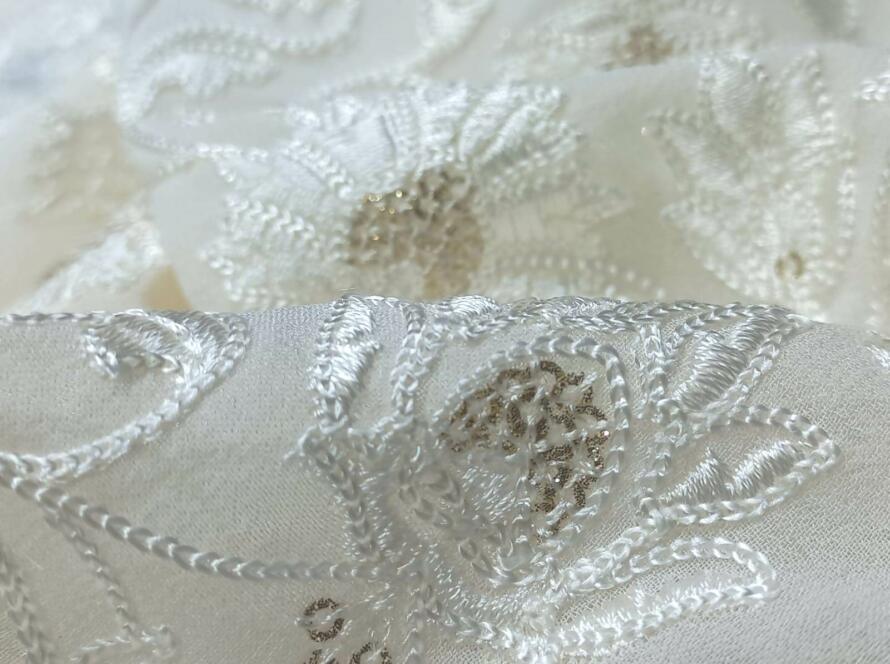Chiffon saree fabric, especially adorned with intricate embroidery designs, is a beloved textile in the world of Indian fashion.
The fabric’s lightness, grace, and delicate texture make it a favorite choice for creating elegant apparel. When combined with embroidery, it transforms into a luxurious option for festive and bridal wear.
Chiffon Saree Fabric with Embroidery Design: A Fashion Staple in India and Beyond
We will explore the versatility of chiffon fabric, why it is so popular in India, the types of garments made from it, and its comparison with digital print and plain RFD fabric.
What is Chiffon?
Chiffon is a lightweight, sheer fabric made from silk, nylon, or polyester. Known for its soft and flowing nature, chiffon has a slight stretch and a beautiful drape, making it ideal for creating garments that are both elegant and comfortable. Its semi-transparent texture adds a touch of ethereal beauty to the wearer, which is why it’s often used in formal and bridal wear. Chiffon can be dyed in vibrant colors or left plain for a subtle, graceful look.
Popular Garments Made from Chiffon Fabric
Chiffon is a versatile fabric that can be used to create a wide range of garments. Some of the most common ones include:
- Sarees: Chiffon sarees are a staple in Indian fashion. The fabric’s lightness and fluidity make it easy to drape, providing a flattering silhouette. When paired with intricate embroidery, these sarees become perfect for weddings, festivals, and special occasions.
- Lehengas: For bridal and festive wear, chiffon lehengas adorned with embroidery are highly sought after. The fabric adds an element of grace and movement to the garment, while the embroidery brings in richness and texture.
- Evening Gowns: Chiffon’s flowing nature makes it ideal for evening gowns. Whether it’s a fully embroidered piece or a simple, elegant drape, chiffon gowns are a popular choice for formal events.
- Dupattas: Embroidered chiffon dupattas add a touch of elegance to any traditional outfit. They are light, comfortable, and often detailed with intricate threadwork or embellishments.
Why is Chiffon Saree Fabric with Embroidery Design Famous in India?
In India, fashion is deeply connected to tradition and celebration. The combination of chiffon with embroidery blends the modern with the traditional, making it a favored choice for women across all age groups. Here’s why it is particularly famous:
- Lightweight and Comfortable: India’s climate can be hot and humid, making lightweight fabrics like chiffon highly desirable. Chiffon’s airy texture allows for breathability, while its soft feel ensures comfort even during long hours of wear.
- Aesthetic Appeal: Chiffon’s natural flow and transparency add a sense of luxury to any garment. When enhanced with detailed embroidery, it becomes a symbol of elegance, making it a go-to for weddings, religious ceremonies, and special occasions.
- Versatility: Whether it’s a saree, lehenga, or dupatta, chiffon’s ability to be styled in various ways adds to its popularity. Embroidery, beadwork, and other embellishments only enhance its beauty.
Embroidery, Digital Print, and Plain RFD Chiffon: A Comparison
Chiffon fabric can be produced in various forms—embroidered, digitally printed, or plain RFD (Ready For Dyeing). Each type of chiffon has its own distinct characteristics and uses.
- Chiffon Embroidery: This type of chiffon is embellished with intricate threadwork, mirror work, sequins, or beadwork. The embroidery adds texture and depth to the fabric, making it suitable for high-end apparel like sarees, lehengas, and anarkalis. Embroidered chiffon is perfect for occasions where the wearer wants to make a statement.
- Digital Print Chiffon: Digital print chiffon is popular for its vibrant patterns and designs. This method allows for high-resolution prints in a wide range of colors and patterns, making it ideal for casual wear, summer dresses, and less formal sarees. It is less expensive than embroidered chiffon but still offers a stylish look.
- Plain RFD Chiffon: RFD chiffon is a blank fabric that is ready for dyeing. It serves as a canvas for designers to create custom garments. While this fabric is plain, it can be dyed to any color and used for layering, draping, or paired with heavy accessories. It is often used as a base for creating embroidered or printed designs later.
Garments from These Chiffon Variants
All three variants of chiffon—embroidered, digitally printed, and plain RFD—are used to create a wide variety of garments. Embroidered chiffon is typically used for luxurious, formal outfits like bridal sarees, lehengas, and partywear. Digital print chiffon, with its bold and artistic patterns, is often seen in casual wear, modern sarees, and evening dresses. Plain RFD chiffon, on the other hand, offers flexibility for designers to create their own customized pieces, whether through dyeing, printing, or further embellishment.
The Global Appeal of Madhav Fashion’s Chiffon Fabrics
Madhav Fashion, one of Asia’s largest embroidery fabric manufacturers, is renowned for its exquisite fabric creations. Though they operate under non-disclosure agreements with many top brands, their fabrics are featured in some of the world’s most exclusive fashion shows, celebrity wardrobes, and films. Their embroidery designs on chiffon have captured the attention of fashion lovers worldwide, showcasing the versatility and timeless appeal of this fabric.
chiffon saree fabric with embroidery design is a timeless staple in Indian fashion and has a growing global appeal. Its combination of elegance, comfort, and beauty makes it ideal for a wide range of garments, from traditional bridal wear to modern evening gowns. Whether it’s embroidered, digitally printed, or plain RFD, chiffon continues to be a favorite choice for designers and wearers alike.
______________________________________________________
What makes chiffon saree fabric popular in India?
Chiffon saree fabric is highly popular in India due to its lightweight, airy texture, and luxurious feel. The hot and humid climate in many parts of the country makes chiffon a practical choice because of its breathable and comfortable nature. Women prefer chiffon sarees for their fluid drape and ease of wear, especially during long events like weddings or religious ceremonies. The fabric is soft and provides a flowing, elegant silhouette, enhancing the wearer’s figure.
Chiffon sarees are often embellished with embroidery, beadwork, or sequins, making them a favored choice for festive and bridal wear. The embroidery adds depth, richness, and a sense of tradition, while the chiffon itself brings modern sophistication. Whether plain, digitally printed, or embroidered, chiffon sarees are versatile and can be styled in numerous ways, which makes them appealing to women across different age groups. In India, where clothing is often symbolic of tradition, chiffon sarees manage to strike a balance between cultural heritage and contemporary fashion, making them a preferred choice for various occasions.
What types of garments can be made from chiffon saree fabric with embroidery design?
Chiffon saree fabric with embroidery designs is versatile and can be used to create a variety of garments. The most common are sarees, which are a staple in Indian fashion. The lightweight chiffon, combined with intricate embroidery, makes sarees perfect for weddings, festivals, and formal occasions.
In addition to sarees, chiffon fabric is often used to create lehengas (Indian skirts) that are adorned with embroidery for a rich, luxurious look. These lehengas are popular for bridal and festive wear because they offer comfort while maintaining a glamorous appearance. Evening gowns made from chiffon are also in high demand, especially when the fabric is embroidered to add elegance and texture. The natural flow of chiffon makes it ideal for gowns that drape beautifully.
Dupattas (scarves) made from embroidered chiffon add a touch of sophistication to any outfit. Finally, salwar kameez (a traditional Indian outfit) and anarkalis (long flowing dresses) can also be made from this fabric, offering a regal, timeless look. In summary, chiffon saree fabric with embroidery can be transformed into elegant, formal garments suitable for special occasions.
What is the difference between chiffon embroidery, digital print, and plain RFD fabric?
Chiffon fabric comes in various forms—embroidered, digitally printed, and plain RFD (Ready for Dyeing)—each having distinct characteristics.
- Chiffon Embroidery: This fabric is adorned with intricate hand or machine embroidery, including threadwork, sequins, or beadwork. Embroidery adds depth, texture, and a luxurious appeal to the fabric, making it ideal for formal and bridal wear.
- Digital Print Chiffon: This fabric features digitally printed designs that are vibrant, detailed, and available in a wide range of patterns. Digital printing offers greater precision and more complex designs than traditional methods. This variant is popular for casual wear, modern sarees, and summer dresses due to its vibrant appeal.
- Plain RFD Chiffon: RFD chiffon is a blank canvas that is typically used for dyeing and further processing. It is plain, without any designs or embellishments, but offers flexibility for designers to create custom patterns or colors. It is commonly used as a base for future embroidery or printing.
All three types can be used to create garments, but embroidery is more luxurious, digital prints are more casual, and plain RFD is customizable.
Why is chiffon fabric so commonly used in formal and bridal wear?
Chiffon fabric is a popular choice for formal and bridal wear due to its elegant drape, lightweight nature, and sheer finish. The fabric has a natural flow that creates a soft and graceful silhouette, which is highly desirable for formal occasions. It moves easily with the body, making it both comfortable and visually stunning, ideal for long events such as weddings or receptions.
When paired with intricate embroidery, chiffon becomes a luxurious fabric suitable for bridal wear, adding richness and texture without weighing down the garment. Its semi-transparent quality allows for layering, creating depth and dimension, which is perfect for multi-layered bridal outfits like lehengas or sarees.
Chiffon also takes well to embellishments like sequins, beadwork, and zari (gold or silver threadwork), which are often used in bridal clothing. The fabric’s adaptability to embroidery makes it a versatile choice for both modern and traditional bridal designs. Moreover, its lightweight nature ensures that brides can move comfortably throughout the day, making it both a practical and aesthetically pleasing choice for formal occasions.
Can digital print chiffon be used for formal wear or is it more casual?
Digital print chiffon is primarily used for casual and semi-formal garments due to its vibrant and artistic patterns. However, it can also be used for formal wear, depending on the design and how it is styled. The digital printing process allows designers to create intricate, high-resolution prints in various colors and patterns, making it a popular choice for summer dresses, modern sarees, and evening gowns.
For formal occasions, digital print chiffon can be enhanced with embellishments like sequins or paired with luxurious fabrics like silk or satin to create a more sophisticated look. The key to using digital print chiffon for formal wear lies in the design and color palette. Muted, elegant colors or intricate patterns can make the fabric more appropriate for formal events. Additionally, accessorizing the outfit with jewelry, an embroidered blouse, or an ornate dupatta can elevate the overall appearance.
That being said, digital print chiffon remains more common for casual settings because its bold, artistic patterns often exude a fun, laid-back vibe. It’s a versatile fabric, but for high-end formal occasions, embroidered chiffon tends to be preferred.
What is the appeal of Madhav Fashion’s chiffon embroidery fabrics in the global market?
Madhav Fashion is one of Asia’s leading manufacturers of embroidery fabrics, and its chiffon embroidery fabrics have garnered global appeal due to their intricate designs, high-quality craftsmanship, and luxurious feel. Madhav Fashion specializes in creating beautiful, detailed embroidery on chiffon, which is used in a variety of garments for both traditional and modern markets.
Although the company operates under non-disclosure agreements with many top global brands, their fabrics are featured in high-profile settings, including fashion shows, celebrity wardrobes, and films. Fashion designers and brands across the world appreciate Madhav Fashion’s ability to combine traditional embroidery techniques with contemporary fashion trends, creating versatile fabrics that cater to a wide range of tastes.
Their fabrics are not only popular in India but also in fashion capitals such as Paris, Milan, and New York, where their embroidered chiffon fabrics are used to create couture gowns, bridal wear, and evening dresses. The global appeal of their chiffon embroidery fabrics lies in the balance between tradition and innovation, as well as the versatility of the fabric itself, which can be adapted to various fashion trends and markets.
How can plain RFD chiffon be customized for fashion design?
Plain RFD chiffon (Ready For Dyeing) offers endless possibilities for customization, making it a popular choice among fashion designers. Since it is untreated and free of any designs or embellishments, it acts as a blank canvas that can be transformed based on the designer’s vision. Here’s how it can be customized:
- Dyeing: The fabric can be dyed in any color, allowing designers to create custom palettes that match their collection or brand aesthetic. Dyeing techniques such as ombre, dip-dye, or tie-dye can also be applied to create unique color effects.
- Printing: Designers can use digital printing or block printing to add intricate patterns, motifs, or graphics to the RFD chiffon. This method offers the flexibility to incorporate modern designs, floral patterns, or even abstract art into the fabric.
- Embroidery: Once dyed, RFD chiffon can be enhanced with embroidery, adding texture and luxury to the fabric. Designers can choose from threadwork, sequin work, or mirror work to create high-end garments suitable for formal wear.
In summary, RFD chiffon provides a flexible foundation that can be customized with dyeing, printing, or embroidery to create unique, personalized fashion pieces.
What should one consider when selecting a chiffon saree with embroidery for special occasions?
When selecting a chiffon saree with embroidery for special occasions like weddings, festivals, or parties, several factors should be considered:
- Fabric Quality: Look for high-quality chiffon that drapes well and feels soft to the touch. The fabric should be lightweight but durable enough to support the embroidery without tearing or sagging.
- Embroidery Design: The type of embroidery on the saree plays a crucial role in its overall appeal. Intricate designs with threadwork, sequins, or beads add elegance and richness to the saree. Choose embroidery that complements the occasion; for weddings or festive events, opt for heavier, more detailed work.
- Color and Aesthetic: The color of the saree should match the tone of the event. Rich colors like reds, golds, and pastels are often preferred for weddings, while lighter, more casual colors work well for parties or festivals.
What occasions are best suited for wearing chiffon sarees with embroidery?
Chiffon sarees with embroidery are incredibly versatile and can be worn for various occasions, both formal and informal. Their lightweight and elegant design makes them particularly suitable for:
- Weddings: Chiffon sarees adorned with intricate embroidery are a favorite choice for brides and bridesmaids. They offer a graceful look while allowing ease of movement, which is essential during long wedding celebrations.
- Festivals: Indian festivals such as Diwali, Eid, and Navratri call for vibrant attire. Chiffon sarees with colorful embroidery are perfect for festive gatherings, allowing the wearer to feel festive yet comfortable.
- Cocktail Parties: For evening events and cocktail parties, a chiffon saree with subtle embroidery can make a sophisticated statement. Pairing it with a stylish blouse and contemporary accessories can elevate the overall look.
- Formal Events: Chiffon sarees can be worn to formal occasions like corporate events, award ceremonies, and receptions. The elegant drape and intricate embroidery add a touch of class and professionalism.
- Casual Outings: Lightly embroidered chiffon sarees can also be worn for brunches or casual outings. Choosing softer colors and minimal embroidery can create a relaxed yet chic look.
Overall, the combination of elegance and comfort makes chiffon sarees with embroidery suitable for a wide range of occasions.
Are there any cultural significance or traditions associated with chiffon sarees?
Chiffon sarees hold significant cultural importance in India, intertwining fashion with tradition. While chiffon as a fabric originated in the West, it has been embraced by Indian culture, particularly in the context of sarees. Here are some aspects of its cultural significance:
- Symbol of Elegance: Chiffon sarees are often seen as a symbol of grace and femininity. Their lightweight and flowing nature embodies the traditional Indian aesthetic, making them a preferred choice for women across generations.
- Bridal Attire: In many Indian cultures, chiffon sarees with intricate embroidery are commonly worn by brides during wedding ceremonies. The fabric’s ethereal quality and rich embroidery enhance the bridal look, making it a focal point of the celebration.
- Festive Wear: During festivals, women often wear colorful chiffon sarees, representing joy and celebration. The fabric’s versatility allows for vibrant prints and elaborate embroidery, aligning with the festive spirit.
- Cultural Events: Chiffon sarees are commonly worn during cultural events and performances, showcasing traditional Indian crafts. The fabric allows for easy movement, which is essential for dance and other artistic expressions.
- Modern Adaptation: While chiffon sarees are steeped in tradition, they have also evolved to incorporate contemporary styles, bridging the gap between old and new. This adaptability highlights the fabric’s significance in reflecting cultural identity and fashion trends.
Overall, chiffon sarees embody a rich cultural heritage while remaining a fashionable choice for modern women.
How do you choose the right embroidery style for a chiffon saree?
Choosing the right embroidery style for a chiffon saree involves considering various factors to ensure the final look aligns with the occasion, personal style, and overall aesthetics. Here are some tips for making the right choice:
- Occasion: The type of event significantly influences the embroidery style. For formal occasions such as weddings, opt for heavier, intricate designs with embellishments like sequins, beads, or zari work. For casual events, lighter, minimal embroidery can create a relaxed yet elegant look.
- Personal Style: Consider your own fashion preferences. If you lean towards traditional styles, intricate motifs like floral patterns or paisley designs may appeal to you. If you prefer modern aesthetics, geometric or abstract embroidery can provide a fresh, contemporary look.
- Color Palette: The embroidery color should complement the saree’s base color. For example, a pastel chiffon saree may look stunning with white or silver embroidery, while a bold-colored saree may be enhanced by contrasting colors like gold or deep jewel tones.
- Fabric Weight: The embroidery should not overwhelm the lightweight chiffon. Delicate embroidery will maintain the fabric’s flow and elegance, while heavier designs may weigh it down.
- Layering Options: Consider how the saree will be styled. If you’re pairing it with an embellished blouse or accessories, ensure the embroidery complements rather than competes with these elements.
By thoughtfully considering these factors, you can choose the perfect embroidery style that enhances the beauty of your chiffon saree.
Is chiffon fabric suitable for all body types?
Yes, chiffon fabric is suitable for all body types due to its inherent qualities that promote a flattering silhouette. Here’s how chiffon accommodates different body shapes:
- Lightweight and Flowing: Chiffon is a lightweight and sheer fabric that drapes beautifully, creating a soft and fluid silhouette. This quality allows it to fall gracefully over various body shapes, making it forgiving for those who may be conscious of their curves.
- Versatile Draping: The fabric’s versatility allows for multiple draping styles, enabling women to experiment with different looks that flatter their unique body types. A well-draped chiffon saree can enhance curves, elongate the figure, and create a balanced appearance.
- Layering Potential: Chiffon can be layered with other fabrics to add dimension and structure, catering to individual preferences. For instance, pairing a chiffon saree with a structured blouse or an embroidered jacket can create a polished look that suits various body types.
- Customizable Designs: Chiffon sarees come in various designs, patterns, and embroidery styles, allowing individuals to select what best suits their body shape. Opting for darker colors can provide a slimming effect, while bold prints can draw attention to specific areas.
- Comfort and Movement: The soft texture of chiffon ensures comfort and ease of movement, making it a practical choice for women of all sizes. This comfort contributes to confidence, allowing wearers to feel at ease in any setting.
In summary, chiffon fabric is incredibly versatile and flattering, making it a suitable choice for women of all body types.
What are the fashion trends in chiffon sarees for the upcoming seasons?
Fashion trends for chiffon sarees are constantly evolving, influenced by cultural shifts, designer creativity, and consumer preferences. As we look ahead to upcoming seasons, here are some notable trends expected to dominate:
- Sustainable Fabrics: With an increasing focus on sustainability, many designers are opting for eco-friendly chiffon fabrics made from organic materials or recycled fibers. This trend not only promotes environmental consciousness but also attracts eco-aware consumers.
- Bold Prints and Colors: Expect to see a resurgence of bold, vibrant colors and eye-catching prints in chiffon sarees. Designers are embracing bright hues, floral motifs, and abstract patterns, catering to modern tastes while keeping traditional aesthetics alive.
- Minimalistic Embroidery: While intricate embroidery remains popular, there is a growing trend towards minimalism. Subtle, delicate embroidery adds elegance without overwhelming the fabric, making it suitable for both casual and formal occasions.
- Layered Styles: Layering continues to be a key trend in chiffon sarees, with designers creating innovative drapes and styles. This technique allows for versatility, enabling the wearer to adapt their look for different settings.
- Fusion Styles: The fusion of traditional and contemporary elements is becoming increasingly popular. Designers are experimenting with innovative cuts and unconventional blouses, merging Indian styles with Western fashion trends.
These trends highlight the adaptability of chiffon sarees, ensuring they remain relevant and stylish in the ever-evolving world of fashion.
What accessories pair well with chiffon sarees?
Accessorizing chiffon sarees can elevate the overall look, making it more complete and stylish. The right accessories can enhance the saree’s elegance while reflecting personal style. Here are some accessory ideas that pair well with chiffon sarees:
- Jewelry: Opt for jewelry that complements the saree’s color and embroidery. For heavily embroidered sarees, statement pieces like chandelier earrings or a bold necklace can add glamour. For simpler designs, delicate gold or silver jewelry can enhance the look without overshadowing the saree.
- Bangles: Traditional bangles, whether in gold, silver, or colorful glass, can add charm to the outfit. Stacking different styles of bangles creates a playful, festive vibe, while simple cuffs can maintain a more sophisticated appearance.
- Clutch or Handbag: Choose a clutch or handbag that matches the saree’s color scheme. Embellished clutches can enhance a glamorous look, while simple leather bags can add a modern touch.
- Footwear: Footwear plays a crucial role in completing the look. Choose embellished sandals, juttis (traditional Indian shoes), or elegant heels that are comfortable yet stylish, suitable for the saree’s drape.
- Dupatta or Stole: Layering a matching or contrasting dupatta or stole can add depth to the outfit. A lightweight chiffon dupatta in a complementary color can enhance the saree’s overall aesthetic.
- Hairstyle: A chic hairstyle can enhance the entire look. Loose waves, a sleek bun, or braided hairstyles adorned with flowers or hairpins can complement the elegance of a chiffon saree.
By thoughtfully selecting accessories, you can create a stunning and cohesive look with your chiffon saree.






